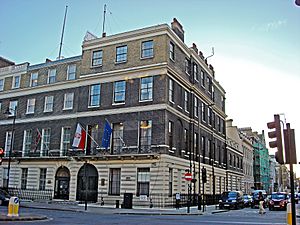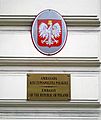Embassy of Poland, London facts for kids
Quick facts for kids Ambasada Rzeczypospolitej Polskiej w Londynie Embassy of the Republic of Poland in London |
|
|---|---|
 |
|
| Location | Marylebone, London |
| Address | 47 Portland Place, London, W1B 1JH |
| Coordinates | 51°31′15″N 0°08′44″W / 51.5208°N 0.1456°W |
| Ambassador | Arkady Rzegocki |
The Embassy of Poland in London is Poland's official office in the United Kingdom. It is called the Polish: Ambasada Rzeczypospolitej Polskiej w Londynie in Polish. You can find it on Portland Place, right next to the building for the High Commission of Kenya. This building is part of a group of historic buildings on Portland Place.
Contents
The Polish Embassy in London: A Look at its History
How the Embassy Started in London
After Poland became independent again in 1918, many Polish leaders focused on building strong relationships with France and Germany. They didn't pay as much attention to Britain, even though Britain had helped Poland after World War I.
Because of this, it wasn't until 1929 that Poland sent its first official group to set up a permanent embassy in London. This new Polish embassy building in London would become very important in Poland's history.
The Embassy During World War II
By the late 1930s, it looked like another world war was going to happen. Poland was still rebuilding after World War I. So, the Polish government asked Britain for military help. Poland also signed an agreement with the United Kingdom and France. This agreement was meant to make sure Poland would not have to fight alone if Germany invaded. Many of the important discussions for these agreements happened at 47 Portland Place, the embassy building.
When World War II began in 1939, the Polish government had to move. First, they went to France, and then they came to London. The Polish Embassy in Portland Place became the main office for Poland's government outside of Poland. It was the central place for Poland's relations with the United Kingdom and for the entire Polish Foreign Office.
The embassy needed more space for all the diplomats and politicians. So, it got other buildings around the city. For a long time, this building showed that democratic Poland was still fighting for its freedom.
Changes After World War II
After World War II ended in 1945, Poland became a satellite state of the Soviet Union. This meant the Soviet Union had a lot of control over Poland. Because of this, the British government stopped recognizing the Polish government that was in London.
The Polish officials in London, often called the "London Poles," had to leave the embassy building on Portland Place. They were only left with the president-in-exile's private home. Meanwhile, officials from the new communist government in Poland moved into the original embassy building.
The Embassy Returns to Democratic Poland
Things changed when communism fell in 1989. The Soviet Union broke apart, and the Berlin Wall came down. Poland became a democratic country again in 1990, led by President Lech Wałęsa.
At this time, the communist government officials left the embassy at 47 Portland Place. It became the official home of the democratic Polish Republic's main office in the United Kingdom once more.
It was at this embassy in London that important symbols of Poland's government were returned. These symbols had been kept safe in London during World War II and the years of Soviet influence. Their return in 1990 helped to fully bring back a free and democratic Poland for the Polish people.
Other Polish Offices in London
The Sikorski Institute and Museum
The Sikorski Institute and Museum is a special place that shares Polish culture and history. It also helps promote tourism to Poland. Located in South Kensington, it has a museum focused on Polish military history. You can see many exhibits about the time when the Polish government was in London during World War II.
Other Embassy Sections
Other parts of the Polish embassy in London include the Consular, Economic, and Commercial Sections. These are all located at 73 New Cavendish Street in Fitzrovia, very close to the main embassy building.
- Consular Section: This part helps people who need a visa to travel to Poland or the Schengen Area. They also handle passport applications and confirm Polish citizenship for both foreigners and Polish citizens. They can help with birth registrations and give advice on many other topics, like what to do if a loved one dies abroad.
- Trade & Investment Promotion Department: Poland also has an office at 90 Gloucester Place in Marylebone that helps with trade and business between Poland and the UK.
Images for kids
-
Plaques outside the embassy, one with the Coat of arms of Poland, and others in English and Polish.




